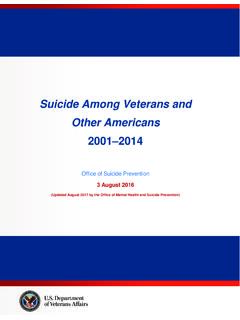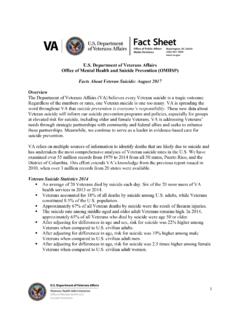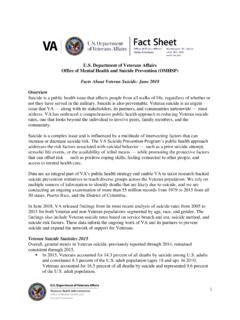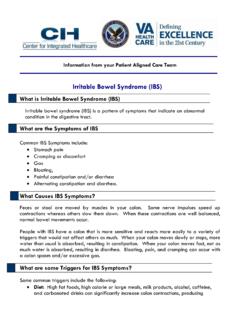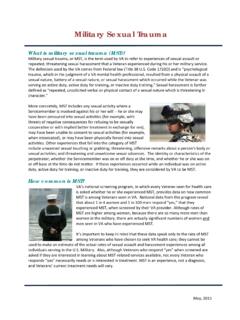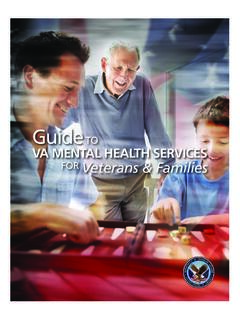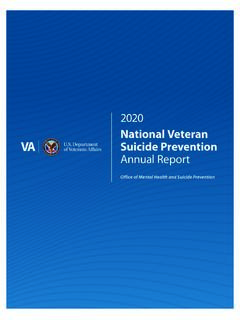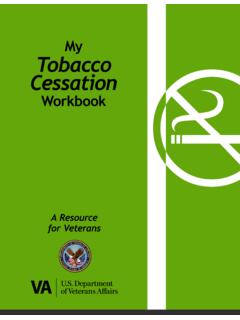Transcription of Outcome Research on 12-Step and Other Self-Help Programs
1 ,.. Moos, R., & Timko, C. (2008). Outcome Research on twelve-step and Other Self-Help Programs . In M. Galanter, & H. O. Kleber (Eds.), Textbook ofsubstance abuse treatment (4th ed. pp. 511-521). Washington, DC: American Psychiatric Press. CHAPTER 36. jIiiii?? ;as Outcome Research on 12-Step and Other Self-Help Programs RudolfH. Moos, Christine Timko, Twelve-step Self-Help groups (SHGs), often called mutual to abstinent role models and rewarding, substance-free activ . help or support groups, are an important component of the ities; a forum wherein individuals can express their feelings in system of infor~al care for patients with substance use disor a safe setting; and a focus for building self-confidence and ders (SUDs). Individuals make more visits to SHGs for help coping skills. The American Psychiatric Association (2000). with their own or family members' substance use and psy recommends referrals to SHGs as an adjunct to the treatment chiatric problems than to all mental health professionals of patients with SUDs.
2 Combined As many as 9% ofadults in the United States have been to an Alcoholics Anonymous (AA) meeting at some time in their lives, and more than 3% have been to a meeting Participation in in the prior year (Room and Greenfield 1993). Moreover, many SUD treatment service providers have adopted 12-Step Self-Help Groups and techniques in treatment, and most of them refer patients to SHGs. Substance Use Outcomes SUD patients have high rates ofposttreatment relapse and Individuals with SUDs who participate in 12-Step SHGs additional episodes ofspecialized care; SHGs may improve tend to experience better alcohol and drug use outcomes the likelihood ofachieving and maintaining remission and re than do individuals who do not participate in these groups. duce the need for further professional care. SHGs provide The most common index of participation has been atten . continuing support, goal direction, and structure; exposure dance at group meetings; however, recent attention has fo- l.
3 Department ofVeterans Affairs Health Services Research and Development Service funds and NIAAA grant AA15685 supported prepara . tion of the manuscript. We thank Bernice Moos for help in reviewing the literature. The views expressed here are the authors' and do not necessarily reflect the views ofthe Department o f Veterans Affairs. 511. -.'~. S:~.. 512 THE AMERICAN PSYCHIATRIC PUBLISHING lEXTBOOK OF SUBSTANCE ABUSE TREATMENT. cused on aspects ofinvolvement, such as reading 12-Step lit 30-month follow-ups was associated with better substance erature, working the steps, obtaining and interacting with a use outcomes at each follow-up; in addition, 6-month atten . sponsor, becoming a sponsor, and doing service work. dance was associated with better 30-month outcomes. Indi . viduals who discontinued attendance or attended intermit . ATTENDANCE AND tently had substance use levels that were similar to those of individuals who reported no regular attendance (Kissin et al.)
4 SUBSTANCE USE OUTCOMES. 2003). Several prospective studies have shown that SHG attendance A prospective study of individuals with alcohol use dis . is associated with good substance use outcomes. Project orders showed that a longer duration of attendance in AA in MATCH was a large clinical trial that compared the Outcome the first year after help seeking was associated with a higher of 12-Step facilitation, cognitive-behavioral, and motiva . likelihood of I-year, 8-year, and I6-year abstinence and free . tional enhancement treatment for patients with alcohol use dom from drinking problems. Moreover, after controlling disorders. Patients who attended AA more often in each 3 . for the duration of AA attendance in year I, the duration of month interval after treatment were more likely to maintain attendance in years 2-3 and 4-8 was related to a higher like- abstinence from alcohol in that interval. In addition, more lihood of I6-year abstinence.
5 Thus, individuals who contin . frequent AA attendance in the first 3 months after treatment ued to attend AA regularly over the long term experienced was related to a higher likelihood of abstinence and fewer al . better substance use outcomes than those who did not (Moos cohol-related consequences in the subsequent 3 months;. and Moos 2006). In addition, the combination of a longer these findings held for patients in each of the three types of duration of AA attendance and better drinking outcomes at treatment (Tonigan et a1. 2003). the l-year follow-up was associated with a lower mortality Comparable findings have been obtained in several rate in the subsequent 15 years (Timko et al. 2006b). Other studies. For example, inpatients with alcohol use dis . These findings hold for SUD patients with different di . orders who attended AA at least weekly reported more re . agnoses. According to Witbrodt and Kaskutas (2005), indi.
6 Ductions in alcohol consumption and more abstinent days at viduals who attended more I2-step group meetings in the a 6-month follow-up than did individuals who attended AA. first 6 months after seeking treatment were more likely to be less frequently or those who did not attend at all (Gossop et abstinent at a 6-month follow-up; those who attended more al. 2003). Alcohol-dependent individuals who participated meetings in the subsequent 6 months were more likely to be in SHGs in the first and second years after intensive outpa . abstinent at a 12-month follow-up. Comparable findings tient treatment were more likely to be abstinent in the sec . were obtained for patients with alcohol use disorder diag . ond and third years, respectively; attendance at two or more noses only, patients with drug use disorder diagnoses only, meetings per week was associated with less severe relapses and patients with both drug and alcohol use disorder diag.
7 (Kelly et al. 2006). noses. In general, the duration of SHG attendance is more Although there is much less empirical evidence, these strongly related to substance use outcomes than is the fre . findings apply to participation in Narcotics Anonymous quency ofattendance. The benefits ofSHGs do not appear to (NA), as would be expected given the commonalities be . be dependent on attending 90 meetings in 90 days. tween AA and NA, which follow the same 12 steps and have similar literature, speaker and step meetings, and home groups and sponsors. Individuals who consistently attended INVOLVEMENT AND. NA at least weekly during a 12-month interval had lower lev SUBSTANCE USE OUTCOMES. els of alcohol and marijuana use at follow-up than did those Attendance is an important indicator ofparticipation, but it who attended NA less consistently (Toumbourou et a1. may not adequately reflect an individual's level of group in- 2002).
8 Among individuals with drug use disorders, those volvement, as shown by such indices as number ofsteps com . who participated only in AA, only in NA, or both in AA and pleted, acceptance of I2-step ideology, and self-identification NA had comparable I-year abstinence rates, all of which as a group member. These and related aspects ofinvolvement were higher than the rate for individuals who did not partic are relatively highly correlated with indices of attendance;. ipate in AA or NA (Crape et al. 2002). nevertheless, aspects of group involvement may be associated Individuals who continue to attend SHGs over a longer with substance use outcomes independent of the duration interval are more likely to maintain abstinence than are indi and frequency of attendance per se. viduals who stop attending. Patients with drug use disorders In support of this idea, individuals who were more ac . who participated in 12-Step groups at least weekly at 6-month cepting of I2-step ideology, especially belief in the need fOI.
9 And 24-month follow-ups were more likely to maintain absti lifelong attendance at 12-Step meetings and the need to sur . nence from both drugs and alcohol (Fiorentine 1999). In an render to a higher power, were more likely to attend 12-steI. Other study, continuous attendaI?-ce at baseline and at 6- and meetings at least weekly. Belief in 12-Step ideology, specifi . Outcome Research on 12-Step and Other Self-Help Programs 513. cally the idea that nonproblematic drug use was not possible, Individuals who delay participating in SHGs may de . was associated with abstinence independent ofl2-step group velop more severe substance use problems before they are attendance (Fiorentine and Hillhouse 2000b). In Project motivated to obtain help and thus may have poorer prog . MATCH, AA attendance, the number of steps completed, noses than individuals who enter SHGs quickly. Most indi . and self-identification as an AA member were most closely viduals who seek formal help for SUDs enter treatment andl associated with abstinence.
10 The composite of these three or SHGs relatively soon. Accordingly, individuals who hesi . items was more highly related to abstinence than was atten tate to join these groups may be less motivated for recovery, dance by itself (Cloud et al. 2004). find it harder to establish a relationship with a sponsor, and In a study of treatment for individuals with cocaine use drop in and out ofSHG groups or attend only intermittently, disorders, active 12-Step involvement in a given month pre a pattern that is associated with poorer outcomes. dicted less cocaine use in the next month. Moreover, patients who increased their 12-Step involvement in the first 3 months of treatment had better cocaine and Other drug use outcomes Connections Between Self . in the next three months. Patients who regularly engaged in 12-Step activities but attended meetings inconsistently had Help Groups and Treatment better drug use outcomes than did patients who attended Many individuals participate in both treatment and SHGs; in consistently but did not regularly engage in 12-Step activities general, these two sources of help appear to strengthen or (Weiss et a1.)
